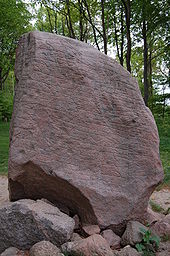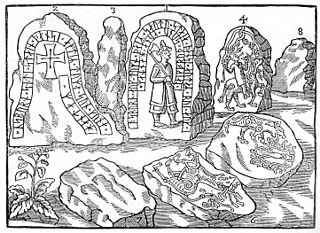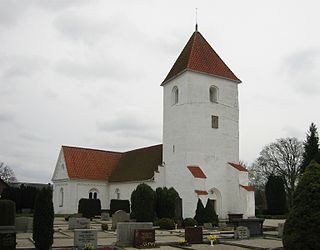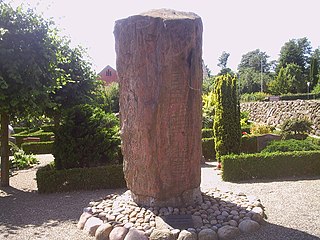


The Glavendrup stone, designated as DR 209 by Rundata, is a runestone on the island of Funen in Denmark and dates from the early 10th century. It contains Denmark's longest runic inscription and ends in a curse.



The Glavendrup stone, designated as DR 209 by Rundata, is a runestone on the island of Funen in Denmark and dates from the early 10th century. It contains Denmark's longest runic inscription and ends in a curse.
The runestone forms the end of a stone ship. There are other megaliths in the vicinity, including memorial stones with Latin characters from the early 20th century. In the stone ship, nine graves have been found, but they were all empty.
The runestone was discovered when sand was quarried in the area in 1794, and it was saved in 1808 by the archaeologist Vedel Simonssen when stonemasons wanted to buy it. The last restoration was made in 1958, and the mound it is standing on is modern.
Ragnhild who ordered the stone also ordered the Tryggevælde Runestone (DR 230) from the runemaster Soti. The runic inscription is classified as being in runestone style RAK. This is the classification for inscriptions with text bands with straight ends that do not have attached serpent or beast heads. It refers to a gothi, who was a pagan priest of a vé, a holy sanctuary, and a thegn, who was the head of the Norse clan and a warchief. The rune carver appeals to the Norse god Thor to hallow the inscription. There are two other runestones that have similar invocations to Thor located in Denmark, DR 110 from Virring and DR 220 from Sønder Kirkeby, and three other stones in Sweden, Ög 136 in Rök, Vg 150 from Velanda and possibly Sö 140 at Korpbron. [1] It has been noted that Thor is the only Norse god who is invoked on any Viking Age runestones. [2]
The inscription ends with a curse, similar to the ones found on the Tryggevælde Runestone and the Sønder Vinge runestone 2 in Denmark and the Glemminge stone and the Saleby Runestone in Sweden. There is some disagreement regarding the translation of one of the words in these curses, rita/rata, which has been translated as "wretch," "outcast," or "warlock." [3] Warlock is the translation accepted by Rundata. However, the use of warlock is not that the destroyer would gain any magical powers, but be considered to be unnatural and a social outcast. [4] The concept that being a warlock or sorcerer was an evil perversion predated the Christian conversion of Scandinavia. [4]
raknhiltr
Ragnhildr
'
sa¶ti
satti
'
stain
sten
þonsi
þænsi
'
auft
æft
¶
ala
Alla
'
saulua
Solwa,
kuþa
goþa
¶
uia
wea,
l(i)þs
liþs
haiþuiarþan
heþwærþan
þia¶kn
þægn.
Ragnhildr placed this stone in memory of Alli the Pale, priest of the sanctuary, honourable þegn of the retinue.
raknhiltr
Ragnhildr
'
sa¶ti
satti
'
stain
sten
þonsi
þænsi
'
auft
æft
¶
ala
Alla,
'
saulua
salvia
kuþa
goþa,
¶
uial(i)þs
vialiþs
haiþuiarþan
heþwærþan
þia¶kn
þægn.
Ragnhildr placed this stone in memory of Alli, priest of the Sølve, honourable þegn of the sanctuary-retinue.
ala
Alla
'
suniʀ
syniʀ
'
karþu
gærþu
¶
kubl
kumbl
'
þausi
þøsi
'
aft
æft
'
faþur
faþur
¶
sin
sin
'
auk
ok
'
hons
hans
'
kuna
kona
'
auft
æft
¶
uar
wær
'
sin
sin.
'
in
Æn
'
suti
Soti
'
raist
rest
'
run¶aʀ
runaʀ
'
þasi
þæssi
'
aft
æft
'
trutin
drottin
'
sin
sin.
¶
þur
Þor
'
uiki
wigi
'
þasi
þæssi
'
runaʀ
runaʀ.
Alli's sons made this monument in memory of their father, and his wife in memory of her husband. And Sóti carved these runes in memory of his lord. Þórr hallow these runes.
at
At
'
rita
ræta(?)
'
sa
sa
'
uarþi
wærþi
'
is
æs
'
stain
sten
þansi
þænsi
¶
ailti
ælti(?)
'
iþa
æþa
aft
æft
'
onon
annan
'
traki
dragi.
A warlock be he who damages(?) this stone or drags it (to stand) in memory of another. [5]

The Jelling stones are massive carved runestones from the 10th century, found at the town of Jelling in Denmark. The older of the two Jelling stones was raised by King Gorm the Old in memory of his wife Thyra. The larger of the two stones was raised by King Gorm's son, Harald Bluetooth, in memory of his parents, celebrating his conquest of Denmark and Norway, and his conversion of the Danes to Christianity. The runic inscriptions on these stones are considered the best known in Denmark. In 1994, the stones, in addition to the burial mounds and small church nearby, were inscribed on the UNESCO World Heritage List as an unparalleled example of both pagan and Christian Nordic culture.

The Jarlabanke Runestones is the name of about 20 runestones written in Old Norse with the Younger Futhark rune script in the 11th century, in Uppland, Sweden.

The Gunderup Runestone, or DR 143, is located in Gunderup, North Jutland County, Jutland, Denmark. It is notable because it is one of few runestones raised in commemoration of a woman.

The Norra Härene Runestone, designated as Vg 59 by Rundata, is a Viking Age memorial runestone that is located on the grounds of Dagsnäs Castle, which is about seven kilometers south of Skara, Västra Götaland County, Sweden, in the historic province of Västergötland.

Sønder Vissing I or DR 55 is a runestone located in the church of Sønder Vissing in eastern Jutland, Denmark. Sønder Vissing is a small settlement located in Horsens municipality approximately 20 kilometres (12 mi) south of Silkeborg, 20 kilometres (12 mi) west of Skanderborg and 40 kilometres (25 mi) northeast of the Viking monuments of Jelling.

Tryggevælde Runestone, designated as DR 230 under Rundata, is a runestone housed in the National Museum of Denmark, in Copenhagen. It is classified as being carved in runestone style RAK, and is dated to about 900 CE.

The Hunnestad Monument, listed as DR 282 through 286 in the Rundata catalog, was once located at Hunnestad at Marsvinsholm north-west of Ystad, Sweden. It was the largest and most famous of the Viking Age monuments in Scania, and in Denmark, only comparable to the Jelling stones. The monument was destroyed during the end of the 18th century by Eric Ruuth of Marsvinsholm, probably between 1782 and 1786 when the estate was undergoing sweeping modernization, though the monument survived long enough to be documented and depicted.

The Hällestad Runestones are three runestones located in the walls of Hällestad Church in Torna-Hällestad, about 20 kilometers east of Lund in Skåne, southern Sweden. Their Rundata identifiers are DR 295, 296, and 297. DR 295 is notable because it is held to be raised in memory of a warrior who fell in the legendary Battle of the Fýrisvellir, near Uppsala, Sweden between the Jomsvikings led by Styrbjörn the Strong and Styrbjörn's uncle Eric the Victorious, the king of Sweden, c. 985. The other stones were raised by the same people, and they probably formed a monument together in memory of comrades lost in the battle. The Karlevi Runestone, the Egtved Runestone and the Sjörup Runestone may be connected to them.
The Greece runestones are about 30 runestones containing information related to voyages made by Norsemen to the Byzantine Empire. They were made during the Viking Age until about 1100 and were engraved in the Old Norse language with Scandinavian runes. All the stones have been found in modern-day Sweden, the majority in Uppland and Södermanland. Most were inscribed in memory of members of the Varangian Guard who never returned home, but a few inscriptions mention men who returned with wealth, and a boulder in Ed was engraved on the orders of a former officer of the Guard.
The England runestones are a group of about 30 runestones in Scandinavia which refer to Viking Age voyages to England. They constitute one of the largest groups of runestones that mention voyages to other countries, and they are comparable in number only to the approximately 30 Greece Runestones and the 26 Ingvar Runestones, of which the latter refer to a Viking expedition to the Caspian Sea region. They were engraved in Old Norse with the Younger Futhark.

The Varangian Runestones are runestones in Scandinavia that mention voyages to the East or the Eastern route, or to more specific eastern locations such as Garðaríki in Eastern Europe.
The Viking runestones are runestones that mention Scandinavians who participated in Viking expeditions. This article treats the runestone that refer to people who took part in voyages abroad, in western Europe, and stones that mention men who were Viking warriors and/or died while travelling in the West. However, it is likely that all of them do not mention men who took part in pillaging. The inscriptions were all engraved in Old Norse with the Younger Futhark. The runestones are unevenly distributed in Scandinavia: Denmark has 250 runestones, Norway has 50 while Iceland has none. Sweden has as many as between 1,700 and 2,500 depending on definition. The Swedish district of Uppland has the highest concentration with as many as 1,196 inscriptions in stone, whereas Södermanland is second with 391.

The Dagstorp Runestone, designated as DR 325 in the Rundata catalog, is a Viking Age memorial runestone that was discovered at Dagstorp, which is about two kilometers northwest of Kävlinge, Scania, Sweden.

The Sønder Kirkeby Runestone, listed as runic inscription DR 220 in the Rundata catalog, is a Viking Age memorial runestone that was discovered in Sønder Kirkeby, which is located about 5 kilometers east of Nykøbing Falster, Denmark.

The Bjäresjö Runestones are three Viking Age memorial runestones originally located adjacent to Bjäresjö Church in Bjäresjö, which is about 3 kilometers northwest of Ystad, Skåne County, Sweden. Two of the stones were discovered near the church, and two of the stones have been moved to other nearby locations. Although these three stones are located in Sweden, they have been given Danish designations because Scania was part of the historic Denmark.
The Bjärby Runestones are two Viking Age memorial runestones located near Grästorp, Sweden, in Bjärby synod, which was in the historic province of Västergötland. The two stones are memorials to men who held the titles thegn and drengr, and one has a depiction of the hammer of the Norse pagan deity Thor.

The Læborg or Laeborg Runestone, listed as DR 26 in the Rundata catalog, is a Viking Age memorial runestone located outside of the village hall or Forsamlinghus in Læborg, which is about 3 kilometers north of Vejen, Denmark. The stone includes two depictions of the hammer of the Norse pagan god Thor.

DR 110, or the Virring stone, is a runestone made of granite that measures 155 cm (61 in) in height, 120 cm (47 in) in width and 27 cm (11 in) in thickness. It is written in Old East Norse in the Younger Futhark, and the runestone style is in a form called RAK.

The Glemminge stone or DR 338 is a Viking Age runestone engraved in Old Norse with the Younger Futhark runic alphabet. It is found in the wall of Glimminge church in Scania, in Ystad Municipality in Sweden. The style of the runestone is the runestone style RAK.
The Tvorup/Torup stone or DR 154 † was a Viking Age runestone engraved in Old Norse with the Younger Futhark runic alphabet, which has disappeared. According to Skonvig the stone would have been located just inside the door of church of Torup, having been moved there from a mound east of the church. The stone must have been lost while being transported to Copenhagen because nothing more is known about it. Skonvig reported that the stone was 2.5 Danish ells high and 1 ell wide. It was made by the same runemaster who made DR 155, and Lerche Nielsen (2010:244f) suggests that the two stones may actually be the same stone. The stone is dated to the period 970–1020, and the style of the runestone was the runestone style RAK.